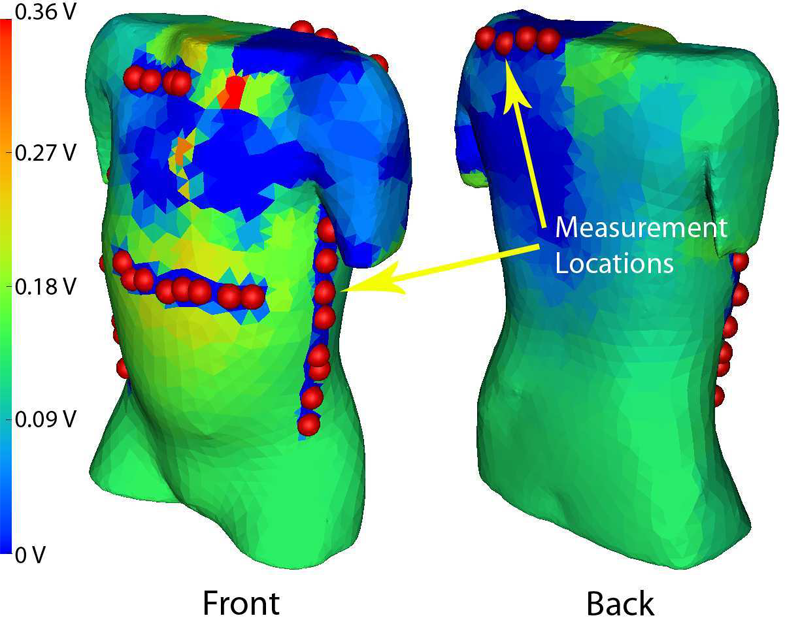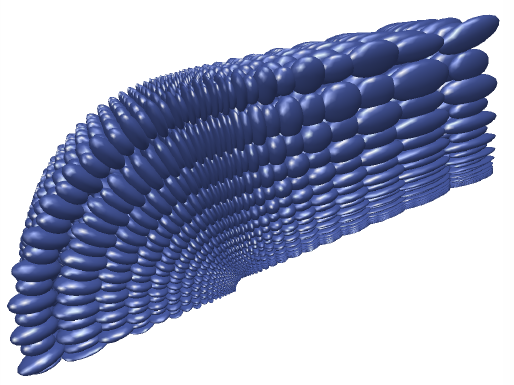2009
M. Milanic, V. Jazbinsek, D.F. Wang, J. Sinstra, R.S. Macleod, D.H. Brooks, R. Hren.
“Evaluation of Approaches of Solving Electrocardiographic Imaging Problem,” In Proceeding of Computers in Cardiology 2010, Park City, Utah, September, 2009.
R.S. Oakes, T.J. Badger, E.G. Kholmovski, N. Akoum, N.S. Burgon, E.N. Fish, J.J. Blauer, S.N. Rao, E.V. DiBella, N.M. Segerson, M. Daccarett, J. Windfelder, C.J. McGann, D.L. Parker, R.S. MacLeod, N.F. Marrouche.
“Detection and quantification of left atrial structural remodeling with delayed-enhancement magnetic resonance imaging in patients with atrial fibrillation,” In Circulation, Vol. 119, No. 13, pp. 1758--1767. 2009.
I. Oguz, M. Niethammer, J. Cates, R.T. Whitaker, P.T. Fletcher, C. Vachet, M. Styner.
“Cortical Correspondence with Probabilistic Fiber Connectivity,” In Information Processing in Medical Imaging (IPMI), Lecture Notes in Computer Science (LCNS), Vol. 5636, pp. 651--663. 2009.
DOI: 10.1007/978-3-642-02498-6_54
S.G. Parker, K. Damevski, A. Khan, A. Swaminathan, C.R. Johnson.
“The SCIJump Framework for Parallel and Distributed Scientific Computing,” In Advanced Computational Infrastructures for Parallel and Distributed Adaptive Applications, Edited by Manish Parashar and Xiaolin Li and Sumir Chandra, Wiley-Blackwell, pp. 149--170. 2009.
DOI: 10.1002/9780470558027.ch9
A.R. Sanderson, M.D. Meyer, R.M. Kirby, C.R. Johnson.
“A Framework for Exploring Numerical Solutions of Advection Reaction Diffusion Equations using a GPU Based Approach,” In Journal of Computing and Visualization in Science, Vol. 12, pp. 155--170. 2009.
DOI: 10.1007/s00791-008-0086-0
N.M. Segerson, M. Daccarett, T.J. Badger, A. Shabaan, N. Akoum, E.N. Fish, S. Rao, N.S. Burgon, Y. Adjei-Poku, E.G. Kholmovski, S. Vijayakumar, E.V.R. Dibella, R.S. Macleod, N.F. Marrouche.
“Magnetic Resonance Imaging-Confirmed Ablative Debulking of the Left Atrial Posterior Wall and Septum for Treatment of Persistent Atrial Fibrillation: Rationale and Initial Experience,” In Journal of Cardiovascular Electrophysiology, Vol. 21, No. 2, pp. 126--132. 2009.
J.F. Shepherd, C.R. Johnson.
“Hexahedral Mesh Generation for Biomedical Models in SCIRun,” In Engineering with Computers, Vol. 25, No. 1, pp. 97--114. 2009.
R. Tao, P.T. Fletcher, R.T. Whitaker.
“A Variational Image-Based Approach to the Correction of Susceptibility Artifacts in the Alignment of Diffusion Weighted and Structural MRI,” In Lecture Notes in Computer Science, Springer, pp. 664--675. 2009.
DOI: 10.1007/978-3-642-02498-6_55
PubMed ID: 19694302
J.D. Tate, J.G. Stinstra, T. Pilcher, and R.S. MacLeod.
“Measuring Implantable Cardioverter Defibrillators (ICDs) During Implantation Surgery: Verification of a Simulation,” In Computers in Cardiology, pp. 473--476. 2009.
ISSN: 0276-6547

D.F. Wang, R.M. Kirby, C.R. Johnson.
“Finite Element Discretization Strategies for the Inverse Electrocardiographic (ECG) Problem,” In Proceedings of the 11th World Congress on Medical Physics and Biomedical Engineering, Munich, Germany, Vol. 25/2, pp. 729-732. September, 2009.
D.F. Wang, R.M. Kirby, C.R. Johnson.
“Finite Element Refinements for Inverse Electrocardiography: Hybrid-Shaped Elements, High-Order Element Truncation and Variational Gradient Operator,” In Proceeding of Computers in Cardiology 2009, Park City, September, 2009.
2008
J. Cates, P.T. Fletcher, Z. Warnock, R.T. Whitaker.
“A Shape Analysis Framework for Small Animal Phenotyping with Application to Mice with a Targeted Disruption of Hoxd11,” In Proceedings of the 5th IEEE International Symposium on Biomedical Imaging (ISBI '08), pp. 512--516. 2008.
DOI: 10.1109/ISBI.2008.4541045
J. Cates, P.T. Fletcher, M. Styner, H. Hazlett, R.T. Whitaker.
“Particle-Based Shape Analysis of Multi-Object Complexes,” In Proceedings of the 11th International Conference on Medical Image Computing and Computer Assisted Intervention (MICCAI '08), Lecture Notes In Computer Science (LCNS), pp. 477--485. 2008.
ISBN: 978-3-540-85987-1
S.E. Geneser, R.M. Kirby, R.S. MacLeod.
“Application of Stochastic Finite Element Methods to Study the Sensitivity of ECG Forward Modeling to Organ Conductivity,” In IEEE Transations on Biomedical Engineering, Vol. 55, No. 1, pp. 31--40. January, 2008.
C.R. Johnson, X. Tricoche.
“Biomedical Visualization,” In Advances in Biomedical Engineering, Ch. 6, Edited by Pascal Verdonck, Elsvier Science, pp. 209--272. 2008.
M. Jolley, J.G. Stinstra, S. Pieper, R.S. MacLeod, D.H. Brooks, F. Cecchin, J.K. Triedman.
“A Computer Modeling Tool for Comparing Novel ICD Electrode Orientations in Children and Adults,” In Heart Rhythm, Vol. 5, No. 4, pp. 565--572. April, 2008.
PubMed ID: 18362024
J. Krüger, K. Potter, R.S. MacLeod, C.R. Johnson.
“Unified Volume Format: A General System For Efficient Handling Of Large Volumetric Datasets,” In Proceedings of IADIS Computer Graphics and Visualization 2008 (CGV 2008), pp. 19--26. 2008.
PubMed ID: 20953270
With the continual increase in computing power, volumetric datasets with sizes ranging from only a few megabytes to petascale are generated thousands of times per day. Such data may come from an ordinary source such as simple everyday medical imaging procedures, while larger datasets may be generated from cluster-based scientific simulations or measurements of large scale experiments. In computer science an incredible amount of work worldwide is put into the efficient visualization of these datasets. As researchers in the field of scientific visualization, we often have to face the task of handling very large data from various sources. This data usually comes in many different data formats. In medical imaging, the DICOM standard is well established, however, most research labs use their own data formats to store and process data. To simplify the task of reading the many different formats used with all of the different visualization programs, we present a system for the efficient handling of many types of large scientific datasets (see Figure 1 for just a few examples). While primarily targeted at structured volumetric data, UVF can store just about any type of structured and unstructured data. The system is composed of a file format specification with a reference implementation of a reader. It is not only a common, easy to implement format but also allows for efficient rendering of most datasets without the need to convert the data in memory.
C. Ledergerber, G. Guennebaud, M.D. Meyer, M. Bacher, H. Pfister.
“Volume MLS Ray Casting,” In IEEE Transactions on Visualization and Computer Graphics (Proceedings of Visualization 2008), Vol. 14, No. 6, pp. 1539--1546. 2008.

S. Lew, C.H. Wolters, A. Anwander, S. Makeig, R.S. Macleod.
“Improved EEG Source Analysis Using Low-Resolution Conductivity Estimation in a Four-Compartment Finite Element Head Model,” In Human Brain Mapping, Vol. 31, December, 2008.
G.-S. Li, X. Tricoche, D. Weiskopf, C.D. Hansen.
“Flow Charts: Visualization of Vector Fields on Arbitrary Surfaces,” In IEEE Transactions on Visualization and Computer Graphics, Vol. 14, No. 5, pp. 1--14. September/October, 2008.
Page 14 of 24